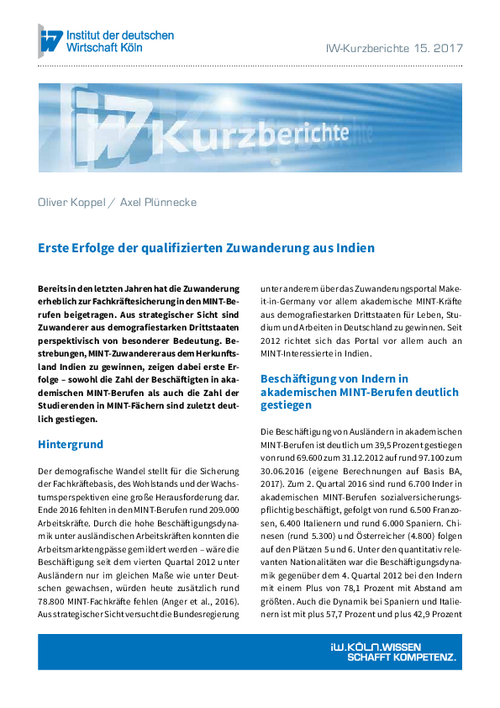In recent years, qualified immigration has started to play a significant role for the German labour market, especially for securing skilled STEM (science, technology, engineering, and mathematics) employment. Efforts made to attract STEM immigrants from India are starting to show signs of success – both the number of employees in academic STEM jobs and the number of students in STEM disciplines have increased significantly in recent times. From a strategic viewpoint, this immigration from demographically strong non-European countries is particularly important for the future.

Qualified immigration from India showing signs of success
IW-Kurzbericht

In recent years, qualified immigration has started to play a significant role for the German labour market, especially for securing skilled STEM (science, technology, engineering, and mathematics) employment. Efforts made to attract STEM immigrants from India are starting to show signs of success – both the number of employees in academic STEM jobs and the number of students in STEM disciplines have increased significantly in recent times. From a strategic viewpoint, this immigration from demographically strong non-European countries is particularly important for the future.
Background
Demographic change represents a significant challenge when it comes to securing a skilled worker base, prosperity, and growth prospects. By the end of 2016, around 209,000 workers were still needed to fill STEM jobs. German labour market shortages were partially eased by an employment boost among foreign workers if STEM-employment among foreigners had not grown nine times stronger than among natives in the last four years, the labour market would now be lacking an additional 78,800 skilled STEM workers (Anger et al., 2016). From a strategic viewpoint, the German government is using the immigration portal Make-it-in-Germany, among other things, in a bid to attract academic STEM workers from demographically strong non-European countries to live, study and work in the country. Since 2012, the portal has also placed a focus on STEM-potentials from India.
Academic STEM employment in Germany: India rises to the top
The employment of foreigners in academic STEM jobs has experienced a major increase of 39.5 percent, rising from around 69,600 on 31/12/2012 to around 97,100 on 30/06/2016 (calculations based on Federal Employment Agency (BA) statistics, 2017). In the second quarter of 2016, around 6,700 Indians subject to social security contributions were employed in academic STEM jobs, followed by around 6,500 French, 6,400 Italians and around 6,000 Spaniards. Chinese (around 5,300) and Austrian (4,800) workers occupied places 5 and 6. Of those nationalities deemed quantitatively relevant, the employment dynamic among Indians showed by far the largest increase at 78.1 percent – compared to the fourth quarter of 2012. With respective increases of 57.7 percent and 42.9 percent, the dynamic among Spaniards and Italians was also greater than the average for all foreigners.
The weak labour market in those two European nations is likely to have contributed to the fact that so many young STEM academics are looking to Germany as they seek employment opportunities on the European Single Market.
The number of Indian STEM students in Germany almost doubled over the last 3 years
There has also been dynamic growth in the number of students in STEM disciplines in recent years. While around 121,700 foreign students were registered at German colleges in the winter semester of 2012/13, this figure had increased by 28.7 percent to approximately 156,600 by 2015/16 (calculations based on Federal Statistical Office figures, 2013; 2016). Among those countries representing the most employees in academic STEM jobs, though, only a few make it to the top countries with respect to STEM enrolment. With around 20,800 students in the winter semester of 2015/16, China takes the top spot of foreign students in STEM disciplines, followed by India in third place with around 11,600 students, Italy in seventh place with around 4,200 students and Austria in ninth place with around 3,400 students. India stands out when it comes to growth among foreign students, with an 88.3 percent increase in a period of just three years. There was also a rise of 37.6 percent among Italians, which is more than the overall number for foreign students in STEM disciplines.
High and increasing focus on STEM among Indian students in Germany
For both employees subject to social security contributions and students, the high increases in the STEM field are obviously not the mere result of a general employment or study trend; rather, the STEM-focused strategy used to secure skilled workers is starting to make a positive impact. The following employment and educational developments since the end of 2012 are indicative of this:
- While the proportion of foreigners subject to social security contributions working in academic STEM jobs stood at 3.1 percent in both the fourth quarter of 2012 and the second quarter of 2016, and the corresponding figure for Germans rose slightly from 3.7 to 4.0 percent, the percentage of Indians increased significantly from 21.1 to 22.1. Almost one in four Indian employees subject to social security contributions holds an academic STEM position – whereas it is only one in 25 among German employees. Furthermore, India’s benchmark is considerably higher than the figures for Chinese (16.4 percent), Spaniards (9.3 percent), French (8.4 percent), Austrians (7.8 percent), and Italians (2.6 percent), which have all grown less dynamically since the end of 2012.
- The situation among students parallels: Between the winter semesters of 2012/13 and 2015/16, the STEM-share among all foreign students rose from 43.3 to 46.0 percent. Among Indian students, the STEM-share increased from 81.5 to 84.1 in the same period, representing the global benchmark. The respective numbers for China (60.0 percent), Spain (35.9 percent), Italy (31.4 percent), Austria (28.2 percent) and France (26.6 percent) are all lower – some of them significantly so – and in the last three years there have only been slight rises among Chinese, Austrians, and Italians, while the proportion of French and Spaniards has fallen slightly.
Outlook
The high STEM increase among Indians – both in employment and in education – clearly illustrates that in addition to short-term labour market impulses, long-term prospects also play a decisive role in migration. According to Alichniewicz/Geis (2013), one in two international graduates remains in Germany after the exam and gets a firm foothold in the labour market, fuelling hopes that the beneficial rise of Indian STEM employment is likely to continue in the next decade. Even more so, it gives rise to networks for potential immigrants from India, and migration networks are an utmost important factor for determining future migration flows (Munshi, 2003). In the past, EU countries in particular were the main countries of origin for immigrants arriving in Germany. Geis et al. (2016) show that these very countries are now facing demographic challenges themselves, meaning that for the medium to long-term future, the demographically strong and well-educated regions of Asia, in particular, now have a crucial role to play in securing the skilled workers base in Germany.

Oliver Koppel / Axel Plünnecke: Erste Erfolge der qualifizierten Zuwanderung aus Indien
IW-Kurzbericht

More on the topic

Securing skilled workers through immigration to universities
Against the backdrop of demographic change, Germany is increasingly dependent on skilled labour from abroad to secure growth and prosperity.
IW
Record immigration not only due to flight from Ukraine
In 2022, more people immigrated to Germany than ever before in the history of the Federal Republic. Around 1.46 million more people moved here than left the country, which is more than a quarter more than the previous record of 1.14 million from 2015.
IW